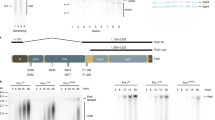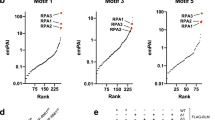Abstract
The replication checkpoint controls the integrity of replicating chromosomes by stabilizing stalled forks, thus preventing the accumulation of abnormal replication and recombination intermediates that contribute to genome instability. Checkpoint-defective cells are susceptible to rearrangements at chromosome fragile sites when replication pauses, and certain human cancer prone diseases suffer checkpoint abnormalities. It is unclear as to how the checkpoint stabilizes stalled forks and how cells sense replication blocks. We have analysed the checkpoint contribution in controlling replisome–fork association when replication pauses. We show that in yeast wild-type cells, stalled forks exhibit stable replisome complexes and the checkpoint sensors Ddc1 and Ddc2, thus activating Rad53 checkpoint kinase. Ddc1/Ddc2 recruitment on stalled forks and Rad53 activation are influenced by the single-strand-binding protein replication factor A (RFA). rad53 forks exhibit a defective association with DNA polymerases α, ɛ and δ. Further, in rad53 mutants, stalled forks progressively generate abnormal structures that turn into checkpoint signals by accumulating RFA, Ddc1 and Ddc2. We suggest that, following replication blocks, checkpoint activation mediated by RFA-ssDNA filaments stabilizes stalled forks by controlling replisome–fork association, thus preventing unscheduled recruitment of recombination enzymes that could otherwise cause the pathological processing of the forks.
This is a preview of subscription content, access via your institution
Access options
Subscribe to this journal
Receive 50 print issues and online access
$259.00 per year
only $5.18 per issue
Buy this article
- Purchase on Springer Link
- Instant access to full article PDF
Prices may be subject to local taxes which are calculated during checkout




Similar content being viewed by others
References
Aparicio OM, Weinstein DM and Bell SP . (1997). Cell, 91, 59–69.
Araki H, Leem S-H, Phongdara A and Sugino A . (1995). Proc. Natl. Acad. Sci. USA, 92, 11791–11795.
Bartek J and Lukas J . (2003). Cancer Cell, 3, 421–429.
Boddy MN and Russell P . (2001). Curr. Biol., 11, R953–R956.
Brown EJ and Baltimore D . (2003). Genes Dev., 17, 615–628.
Brush GS and Kelly TJ . (2000). Nucleic Acids Res., 28, 3725–3732.
Brush GS, Morrow DM, Hieter P and Kelly TJ . (1996). Proc. Natl. Acad. Sci. USA, 93, 15075–15080.
Casper AM, Nghiem P, Arlt MF and Glover TW . (2002). Cell, 111, 779–789.
Cha RS and Kleckner N . (2002). Science, 297, 602–606.
Cimprich KA . (2003). Curr. Biol., 13, R231–R233.
Deshpande AM and Newlon CS . (1996). Science, 272, 1030–1033.
Dimitrova D and Gilbert D . (2000). Nat. Cell Biol., 2, 686–694.
Edwards RJ, Bentley RJ and Carr AM . (1999). Nat. Cell Biol., 1, 393–398.
Foiani M, Lucchini G and Plevani P . (1997). Trends Biochem. Sci., 22, 424–427.
Foiani M, Pellicioli A, Lopes M, Lucca C, Ferrari M, Liberi G, Muzi MFM and Plevani P . (2000). Mutat. Res., 451, 187–196.
Friedman KL and Brewer BJ . (1995). Methods Enzymol., 262, 613–627.
Garvik B, Carson M and Hartwell L . (1995). Mol. Cell. Biol., 15, 6128–6138.
Hübscher U, Nasheuer H-P and Syväoja JE . (2000). Trends Biochem. Sci., 25, 143–147.
Ivessa AS, Zhou JQ and Zakian VA . (2000). Cell, 100, 479–489.
Kai M and Wang TS-F . (2003). Genes Dev., 17, 64–76.
Kamimura Y, Tak Y-S, Sugino A and Araki H . (2001). EMBO J., 20, 2097–2107.
Kondo T, Wakayama T, Naiki T, Matsumoto K and Sugimoto K . (2001). Science, 294, 867–870.
Kornberg A and Baker T . (1992). DNA Replication. WH Freeman and Company: New York.
Labib K, Tercero JA and Diffley JFX . (2000). Science, 288, 1643–1647.
Lee SE, Moore JK, Holmes A, Umezu K, Kolodner RD and Haber JE . (1998). Cell, 94, 399–409.
Lee SE, Pellicioli A, Malkova A, Foiani M and Haber JE . (2001). Curr. Biol., 11, 1053–1057.
Longhese MP, Neecke H, Paciotti V, Lucchini G and Plevani P . (1996). Nucleic Acids Res., 18, 3533–3537.
Longhese MP, Paciotti V, Fraschini R, Zaccarini R, Plevani P and Lucchini G . (1997). EMBO J., 16, 5216–5226.
Lopes M, Cotta-Ramusino C, Pellicioli A, Liberi G, Plevani P, Muzi-Falconi M, Newlon CS and Foiani M . (2001). Nature, 412, 557–561.
Marini F, Pellicioli A, Paciotti V, Lucchini G, Plevani P, Stern DF and Foiani M . (1997). EMBO J., 16, 639–650.
Melo JA, Cohen J and Toczyski DP . (2001). Genes Dev., 15, 2809–2821.
Navas TA, Zhou Z and Elledge S . (1995). Cell, 80, 29–39.
Newlon CS, Collins I, Dershowitz A, Deshpande AM, Greenfeder SA, Ong LY and Theis JF . (1993). Cold Spring Harb. Symp. Quant. Biol., 58, 415–423.
Osborn AJ, Elledge SJ and Zou L . (2002). Trends Cell Biol., 12, 509–516.
Paciotti V, Clerici M, Lucchini G and Longhese MP . (2000). Genes Dev., 14, 2046–2059.
Pâques F and Haber JE . (1999). Microbiol. Mol. Biol. Rev., 63, 349–404.
Pellicioli A, Lee SE, Lucca C, Foiani M and Haber JE . (2001). Mol. Cell, 7, 293–300.
Pellicioli A, Lucca C, Liberi G, Marini F, Lopes M, Plevani P, Romano A, Di Fiore PP and Foiani M . (1999). EMBO J., 18, 6561–6572.
Rouse J and Jackson SP . (2000). EMBO J., 19, 5801–5812.
Rouse J and Jackson SP . (2002). Mol. Cell, 9, 857–869.
Shiloh Y . (2001). Curr. Opin. Genet. Dev., 11, 71–77.
Sogo JM, Lopes M and Foiani M . (2002). Science, 297, 599–602.
Strahl-Bolsinger S, Hecht A, Luo K and Grunstein M . (1997). Genes Dev., 11, 83–93.
Tercero JA and Diffley JFX . (2001). Nature, 412, 553–557.
Tercero JA, Longhese MP and Diffley JFX . (2003). Mol. Cell, 11, 1323–1336.
Umezu K, Sugawara N, Chen C, Haber JE and Kolodner RD . (1998). Genetics, 148, 989–1005.
Vaze MB, Pellicioli A, Lee SE, Ira G, Liberi G, Arbel-Eden A, Foiani M and Haber JE . (2002). Mol. Cell, 10, 1053–1057.
Wold MS . (1997). Annu. Rev. Biochem., 66, 61–92.
Zhao X, Muller EG and Rothstein R . (1998). Mol. Cell, 2, 329–340.
Zou L and Elledge SJ . (2003). Science, 300, 1542–1548.
Acknowledgements
We thank H Araki and Y Kamimura for help in the ChIP procedure, M Lopes, J Sogo and all members of our laboratory for helpful discussions, K Shirahige for communicating unpublished results and H Araki for critical reading of the manuscript. This work was supported by Associazione Italiana per la Ricerca sul Cancro and European Union (Grant RTN2-2001-00177). CL and FV were supported by Adriano Buzzati-Traverso fellowships. JEH was supported by NIH Grants GM20056 and GM61766.
Author information
Authors and Affiliations
Corresponding author
Rights and permissions
About this article
Cite this article
Lucca, C., Vanoli, F., Cotta-Ramusino, C. et al. Checkpoint-mediated control of replisome–fork association and signalling in response to replication pausing. Oncogene 23, 1206–1213 (2004). https://doi.org/10.1038/sj.onc.1207199
Received:
Revised:
Accepted:
Published:
Issue Date:
DOI: https://doi.org/10.1038/sj.onc.1207199
Keywords
This article is cited by
-
Acute hydroxyurea-induced replication blockade results in replisome components disengagement from nascent DNA without causing fork collapse
Cellular and Molecular Life Sciences (2020)
-
S-phase checkpoint regulations that preserve replication and chromosome integrity upon dNTP depletion
Cellular and Molecular Life Sciences (2017)
-
DNA replication stress: from molecular mechanisms to human disease
Chromosoma (2017)
-
Replication stress: getting back on track
Nature Structural & Molecular Biology (2016)
-
Genetic and biochemical evidences reveal novel insights into the mechanism underlying Saccharomyces cerevisiae Sae2-mediated abrogation of DNA replication stress
Journal of Biosciences (2016)



